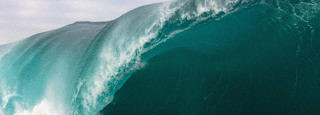
The most dangerous wave in Brazil
Friday, December 2, 2016
Daniel Rangel is the code name of ‘Cabeça’ a carioca surfer who isn’t afraid of big waves or big rocks. At 32, he’s one of the few impetuous people who face the Gardenal Slab, located 2 km from the beach of Barra da Tijuca and named after a controlled medication – a wave considered by him and other experts the most dangerous in Brazil. We chatted about the risks and rewards of surfing in slabs, a sport that grows more and more every day.
‘Cabeça’ facing Gardenal Slab. Image: Ready 2 Fly
– How did your surfing career begin?
I surf since I was born. I started competing at the age of 9, had an amateur career and have been surfing ever since. At 18, I moved to Hawaii, on an island north of Oahu, not crowded at all and with very challenging waves. Like Pipe and Backdoor, there you can find other remoted places with harsh conditions, where you learn to let go of your fear. I stayed there for almost 10 years without coming back. I was almost a local, but today I’m more here than there. In the summer, I used to go to Tahiti, because I always liked to surf powerful waves, like Teahupoo.
– What are slabs and how did you become interested in them?
The slabs are different waves, which break in very shallow water. When I returned to Brazil, I made friends with a group of people who were exploring the slabs of Rio, like Paulo Curi, Felipe Munga, and Felipe Cesarano, who were among the first people to conquer the Gardenal wave. There’s always a very big expectation before the swell, because everyone wants to go and we don’t usually have waves like that in Brazil. It has to be a very big day. So we started getting together as a group and surfing a lot of slabs throughout Rio. This thing boomed, the people here are taking it to another level, getting scrapes and bruises, but still getting out there.
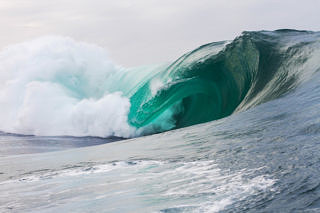
Gardenal showing it's jaws. Photo: Igor Hossmann
– Is there any special preparation for surfing such a wave?
I’m not the most athletic guy in the world, but I’ve always been able to do the things I wanted without injuring myself. I’ve also never had a problem getting fit. Sure, in the week that you’re gonna go to a slab, you shouldn’t go out for that beer, you need to take better care of yourself, to make sure that your body will be ready. You know in advance that you’re gonna get really beaten up.
– And how do you get to the Gardenal Slab?
The slab is next to the Tijuca Islands, about 2 km off the beach of Barra. We always go by jet-ski, because if someone gets hurt, we need it to get back asap. We leave the Marapendi canal through a very nice route, where there’s a lot of interaction with nature. You see the state the canal’s in, if it’s really dirty… You see sewage coming out of the buildings. This ends up creating a very empathetic relationship with nature. Because, deep down, you know your faith is in its hands.
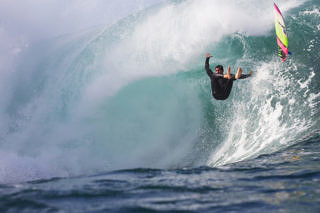
Paulo Curi, one of the most seasoned, in the eye of the storm. Photo: Igor Hossmann
I can safely say that Gardenal is the most dangerous wave in Brazil, if not one of the most dangerous in the world. Everyone who knows the place knows this.
Nature’s sheer beauty and power. Image: Pedro Fortes
– What makes the Gardenal wave so dangerous?
Its depth, the fact that the wave breaks at the tip of really shallow rocks, part of which don’t have any water at all. If you stay on that part of the wave to ride inside the tube (that’s what everyone wants) and fall, you’re going to hit the rock, that’s for sure. The question is how you’ll hit it – hard or smoothly, on your head or on your back. I hit my butt once and limped for a week. Pedro Calado, renowned big rider, was all scraped when he came out of the last swell, and had to be stitched up. Munga also hit his back there. Everyone who tried to ride inside the tube got hurt. For now, the slab’s winning by 3 x 0.
– Can you get there paddling?
No, only with the jet-ski, it’s impossible to surf Gardenal paddling. Maybe in the edge of the wave, but to ride inside the tube and surf the whole wave, it’s impossible. It comes with so much water that you need the help of a machine. Most slabs come in a size for which you need a jet-ski. It’s a very large water displacement, which makes it humanly impossible. It’s like Teahupoo, when it gets huge.
– What’s the difference between the Gardenal and the Teahupoo waves?
Listen, in Gardenal the slab is shallower and the wave is less perfect. Teahupoo is more perfect. But the way the wave comes is very similar and, coincidentally, so is the good direction of the swell. When it comes from a certain angle, it makes a bowl, which is where the tube forms. But even a small change on the direction of the swell and the wind can mess up the conditions here. Obviously Teahupoo gets much bigger swells, it reaches up to 25-30 feet. But I’ll tell you something: here, with 10 feet waves, it hits you with the same force, and it’s even more dangerous. Even the people who have a lot of experience there and who’ve already been to Gardenal say so. Teahupoo is a real wave, there’s more water below and a more defined reef. Here, there’s a tip of a rock that happens to generate momentum. It’s pretty weird.
– What other slabs do you usually go to?
There are several others, like the Shore of Copacabana, the Shock of Itacoatiara, with Bruninho Santos, the Slab of Ipanema, those in Angra. Now the guys are going there, discovering. When they find out that there will be a swell, they go to the tip of the island. It’s leading to this whole movement, which is relatively new in the world, as well. About 8 years ago, the Australians, who are the pioneers in this sport, began to explore the slabs and it boomed.
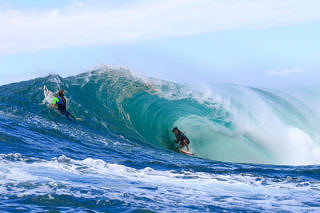
In Angra, Cabeça deep in the barrel and Caio Vaz with the best seat in the house. Photo: Igor Hossmann
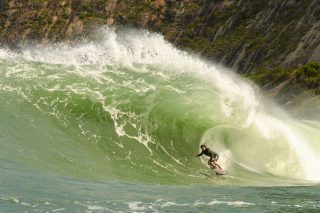
The Shock Slab on fire. Photo: Túlio Henrique
– How many times a year do these waves break?
The thing is that there are few opportunities. We had few chances. If that happened every week, we’d be on another level. But since it happens 5, 6 times a year, the process of figuring out the wave is slower. But when it does happen, we’re always there.
– And the equipment?
This is the hard part in this sport. The costs are very high, both the risks to your health and the money spent on fueling the jet, on the vests and the sleds, which are are expensive… It’s a costly sport, and the equipment is crucial. We always help one another, split the costs between us, borrow money from friends. Everyone finds their own way to make it work, and we always help each other out. It’s a team sport, the guys end up becoming a real family. We also put our lives at risk for the sake of others. If something happens, if someone gets hurt, you’re gonna jump and try to save them. It really is a mini-family. It’s really cool.
– What’s goes trough your mind when you’re out there?
Usually there are 2 skis pulling us, and we’re about 6 surfers. We stay on the canal waiting and, when the sets come in, you don’t know what the wave will be like. The guy can put you in the best wave of your life, or the worst. Paulo Curi is the most experienced pilot, he was the one who put me in my best waves. He’s one of the people who know the place better, and he’s surfed some of the best waves ever surfed there. I trust him a lot. Once he pulled me in and, at the last second, he turned back and shouted “No!” I held tight to the rope and he pulled me out. You slowly get the hang of the wave, the angles, whether it’ll be good or bad. You can measure it up to a certain point, but it’s hard to tell.
Above: ‘Cabeça’ trying to avoid the rocks at Shock. Below: ‘Cabeça’ pulling in in a perfect close-out. Images: Ready 2 Fly
– And after you get on the wave?
That’s the fun part. At the end of the day, everyone goes home scraped and happy. That’s what makes you come back, that feeling of being in the middle of a whirlwind, just like those tornado hunters who want to get as close as possible. The big rider also has that feeling. The equipment and the rescue techniques make a huge difference. It’s a fine line between the risk and that feeling. The night before, you think about it. You imagine the case scenarios and think that, one of these days, you can get out of there carried straight to the hospital.
– How do you assess the risks?
The guy who does BASE jumping should understand more or less this feeling of being at risk. There are people who surf giant waves that get there and don’t want to take the risk, and that’s normal. Because those are barely waves. The guy who has access to good waves won’t want to take a chance there. But a man does what he can. I obviously wanted to be surfing in Teahupoo all the time, but at this point of my career I can’t go there that frequently. And that risk thing also throws in a bonus. The fact that no one’s ever ridden a big tube there… The guys have already gotten really close to that, but they still haven’t made it. There has to be a perfect combination for it to be the wave of your life: the right moment, the right wave, the right equipment.
The day someone rides their first tube in Gardenal, gets in deep and comes out, it’s going to be a first. There’s gonna be proof that a human being can get in and out, because so far they’ve only been allowed in.
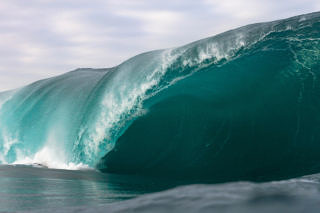
Who will be the first one out? Photo: Igor Hossmann
– And who do you think might be first?
There are very talented people out there. Felipe Cesarano, Scooby, Pedro Calado, Bruninho, Trekinho, Caio Vaz, Paulo Curi, Felipe Munga, a considerable group of Brazilian tube riders and big riders. If there’s anyone able to achieve that, that person’s in this group. Let’s see who’s gonna be the lucky one.
– And how is it to photograph there?
The photographers who always go with us are Igor Hossmann and Pedro Fortes. Over time, we’ve learned that they don’t get the big shots if they stay in the water, because the wave dries up so much that it’s below sea level. Now we take a jet just so the photographers can take pictures from a higher ground.

The photo published by @NikeRio's Instagram. Photo: Igor Hossmann
– And how was the wave of this photo that came out in Nike Rio?
This photo was on the first swell that I surfed there this year, in the week that the WSL was here in Rio. In that wave, I was more up front and turned to its back. Now, looking at the photo, I’m thinking that I should have gone straight, and then turned. Easier said than done, right? (Laughs.) I went there and got to the edge of the wave, in the entrance to the tube. It makes for beautiful pictures, the wave itself is already beautiful. In the next wave, I did what I hadn’t done in the first one, and ended up on the rocks. But it was the best surf feeling that I’ve ever experienced in Brazil. The only time I felt anything like it was at the backside view of a tube in Teahupoo. Here you see the buildings of Barra, because the wave bends and you end up facing the beach. The last thing I saw before falling was the Barramares condo.
– Last question: what wave do you dream of surfing in the next few years?
Man, my biggest goal in life is to surf The Right, in West Oz, and attend the Red Bull Cape Fear championship at Cape Solander, in Ours. I hope I have a chance at it!
If you wanna keep checking Cabeças’s adventures, follow his Instagram.
*All images in this post were provided by our friends Pedro Fortes, Igor Hossmann, Túlio Henrique e Ready2Fly Imagens Aéreas.
Tags: Interview, Ocean, Photography, Surf, Video
Go back to Blog
Assine o Saleiro: nosso jornal digital
Pitadas mensais de criatividade e bom humor para incluir na caixola. Não perca!
